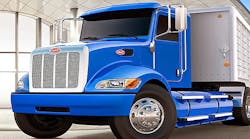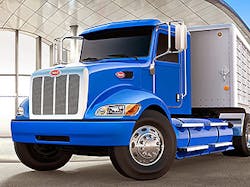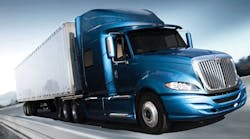Peterbilt Motors Company is introducing two new, medium-duty trucks powered by compressed natural gas, extending its progress on emissions-reduced heavy-duty trucks into the Class 5 and 6 range of commercial vehicles. Both the Model 337 and the Model 348 vehicles are in production now and can be configured as trucks or tractors.
“Peterbilt is the established market leader in natural-gas powered Class 8 commercial vehicles and we’re pleased to bring this expertise to medium-duty markets,” stated general manager Darrin Siver, who also is vice president of PACCAR, the manufacturing holding company of which Peterbilt is one brand unit.
Peterbilt produces medium- and heavy-duty trucks in Denton, Tex.
Both new models are powered by a Cummins Westport ISL-G engine, rated for 320-hp and 1,000 lb.-ft. of torque. The 8.9-liter natural gas engine was developed for school and urban buses, and medium-duty truck and tractor applications. It operates on 100% natural gas, which can be carried on the vehicle in compressed (CNG) or liquefied (LNG) form.
The OEM noted the ISL G engine complies with EPA 2010, 2013 and California Air Resource Board (CARB) emissions regulations, which is an increasingly important factor for fleet operators.
According to Scott Newhouse, Peterbilt chief engineer, the new medium-duty models are optimized for this configuration with 110-inch BBCs (i.e., “bumper to back of cab,” the standard dimensional measurement for medium- and heavy-duty trucks.)
“The CNG Models 337 and 348 give Peterbilt the industry’s most competitive portfolio of natural-gas vehicles,” Newhouse said. “The dimensions provide a BBC two inches shorter than any competitive model and a cab height that is 2.5 inches lower.”
Newhouse said new trucks’ steering geometry provides up to a 50-degree turning angle, which improves maneuverability in congested city and jobsite operations.
“Peterbilt’s award-winning medium-duty trucks – renowned for their versatility, quality and performance – are now available for customers who want to operate with cost effective, environmentally sound CNG,” Siver added. “This is an ideal choice for dump, refuse and short- and regional-haul operations.”











